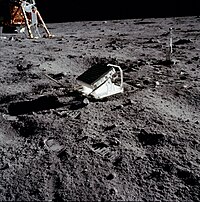
Photo from wikipedia
From June 2009 to September 2014, ten stations of the International Laser Ranging Service acquired more than 5000 h of one-way ranging data to NASA’s Lunar Reconnaissance Orbiter (LRO). The… Click to show full abstract
From June 2009 to September 2014, ten stations of the International Laser Ranging Service acquired more than 5000 h of one-way ranging data to NASA’s Lunar Reconnaissance Orbiter (LRO). The LRO campaign was intended to support the determination of precise science orbits for which S-band Doppler and range measurements are the primary source. The laser ranges were finally not used for the NASA orbits, since the quality of the radiometric data exceeded the expectations. In this contribution, we explore the potential of the LRO laser ranges using an independent software which is able to process all types of LRO tracking data. It is shown that the laser ranges agree with the radiometric data at the level of 5 cm, provided a proper modeling of the LRO clock error is done, including relativistic effects. This accuracy does not fully attain that of the Doppler data, hence the impact of the laser ranges on orbit determination is small, improving the orbit on average by no more than 7 cm. Additional tests without the Doppler data show, however, that the laser ranges would have been of great use if radiometric tracking to LRO were less successful.
Journal Title: Journal of Geodesy
Year Published: 2018
Link to full text (if available)
Share on Social Media: Sign Up to like & get
recommendations!